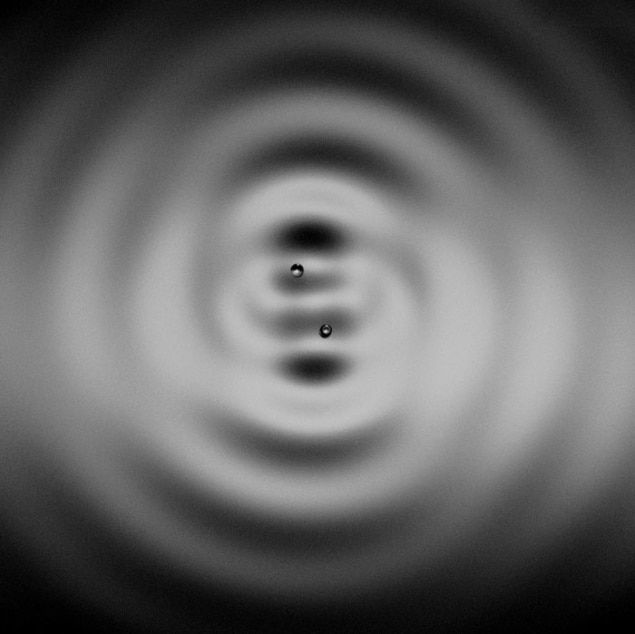
Physicists in France have used pairs of bouncing droplets on a fluid surface to simulate the Zeeman effect – a phenomenon that played an important role in the early development of quantum mechanics. The ability to simulate purely quantum effects using such a classical system could provide insight into how the mathematics of quantum mechanics should be interpreted.
What does the Schrödinger equation mean? The question has been debated by physicists since this central tenet of quantum mechanics was introduced nearly 90 years ago. While its predictive power has been verified many times over in laboratories all around the world, exactly how the solutions to the equation (the wave-fuctions) should be interpreted is still not clear.
The most popular school of thought is the famous “Copenhagen interpretation”, formulated by Niels Bohr and Werner Heisenberg in the 1920s. This probalistic interpretation of quantum mechanics holds that the observable properties of a particle do not have definite values until they are measured. However, this view is not universally accepted and another interpretation of quantum mechanics favoured by some physicists is the so-called “pilot wave” interpretation, formulated by Louis de Broglie in 1927 and later developed by David Bohm. This assumes that the observable properties of quantum particles are defined at all times but that they are guided by a wave, which neatly explains wave–particle duality. This is an example of a hidden variable theory because it explains the measurable properties of quantum mechanics as the consequence of a physically real, but experimentally inaccessible, feature – the wave.
Contrived or intuitive?
The two theories are mathematically indistinguishable, so some physicists see the so-called “Bohm interpretation” as a contrived attempt to explain the experimental results of quantum mechanics without embracing the weirdness of the Copenhagen interpretation. However, in 1980 Michael Berry and colleagues at the University of Bristol in the UK used an analogy with surface waves in a classical fluid to come up with a more intuitive explanation of a bizarre quantum phenomenon called the Aharonov–Bohm effect (discovered by the same Bohm).
Now, Yves Couder at the University of Paris Diderot and colleagues have explored this analogy further by looking at the behaviour of tiny, bouncing droplets called “walkers” as they move across the surface of a vibrating bath of silicone oil. The drops create waves on the surface of the fluid and are, in turn, influenced by these waves. According to Couder, this provides an interesting parallel with the “pilot wave” model of quantum mechanics.
“There is a symbiosis between the droplet and the wave,” explains Couder, “because if there is no droplet there is no wave. And if there is no wave the droplet doesn’t move.” Couder and his colleagues believe that this interaction between a walker and the waves that it creates is an example of wave-particle duality in a classical system because, while the droplet is localized in space like a particle, its motion can be influenced by anything that affects the pilot wave.
Bound states
Couder is emphatic that his group’s system is not an exact analogy to quantum mechanics because, for example, it requires a continuous input of energy by vibrating the bath. Nevertheless, in previous research his group has managed to use walkers to create classical analogies to the quantum effects of single-particle diffraction and tunnelling. It has also shown that two walkers can orbit each other to form bound states, in an analogy to the quantized bound states in an atom.
In the new research, the group investigated the Zeeman effect – a quantum effect whereby the energy levels in an atom split in the presence of an external magnetic field. An atom is a bound state of a nucleus and one or more electrons – and this is simulated using a bound state of two walkers.
To create an analogy to an applied magnetic field, the researchers rotated the bath. The two-walker bound state was then free to rotate either with or against the rotation of the bath – simulating the orbital angular-momentum states of an atom. In the absence of the simulated magnetic field, both of these rotational states have the same energy. However, when the bath is rotated the energy of the rotational states split, with one increasing and the other decreasing – just like the angular-momentum states of an atom in a magnetic field. The team also saw abrupt transitions between energy levels.
Fernando Lund of the University of Chile in Santiago, who has headed a research group looking at similar problems but who was not involved in the current research says: “The most significant feature of this paper, and of others by the same team, is the masterful use of state-of-the-art technology to bring out analogies between classical and quantum physics that can be easily visualized.” He suggests that it might be interesting to try to visualize other quantum phenomena using classical means. “My favourite candidate would be the half-integer spin of some particles like electrons,” he says. “Not that I can see any way of going about answering this question!”
The research is published in Physical Review Letters.



